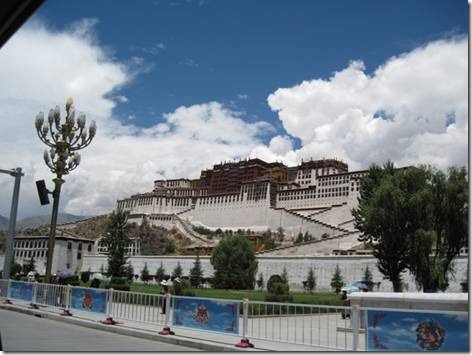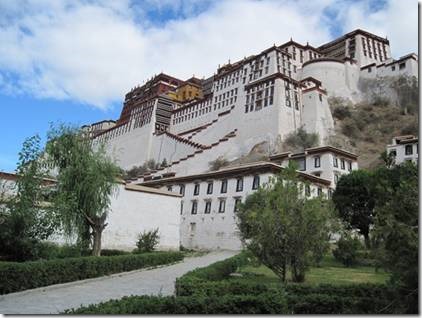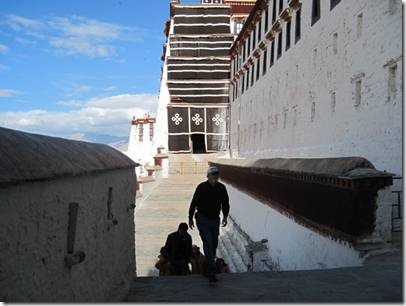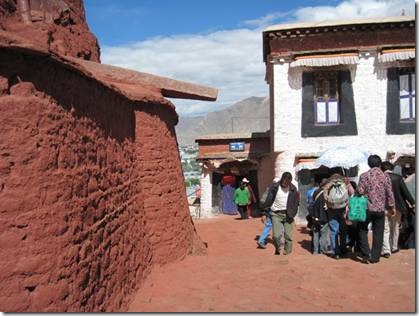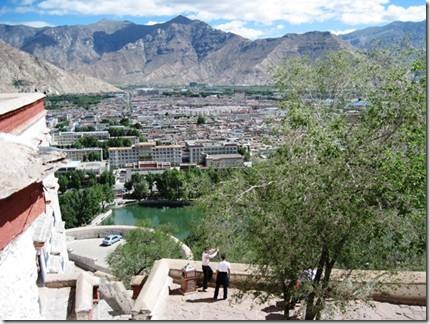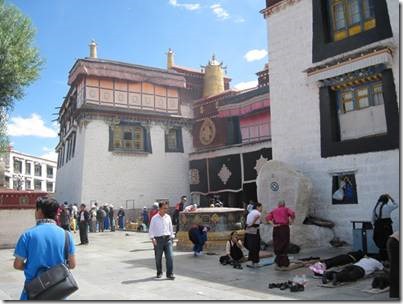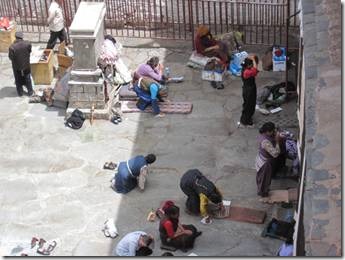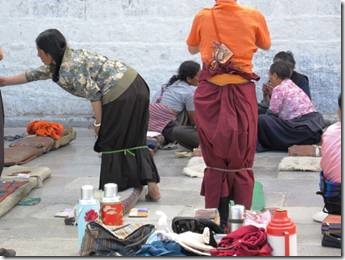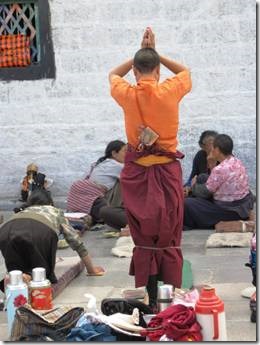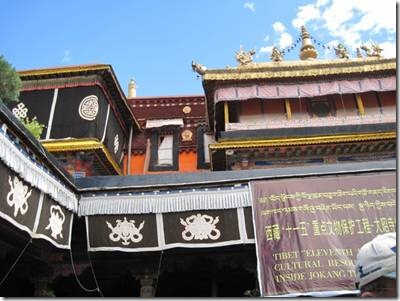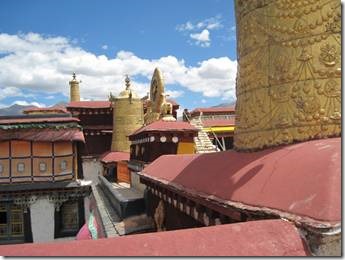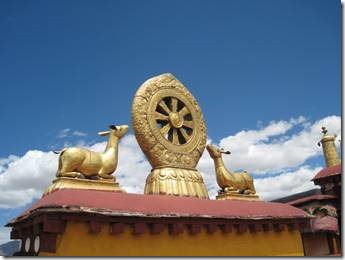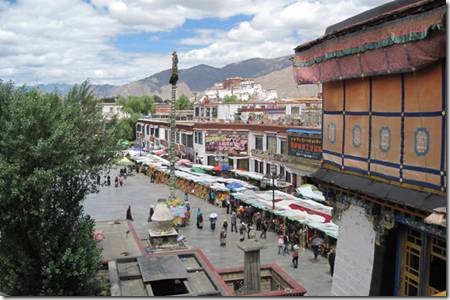Puteri Harbour Marina,
Johor, Malaysia
Hi All,
Continuing our tour of Lhasa……
Tibet # 9 Potala Palace and Jokhang Temple
Potala Palace
Maybe the two most famous sites in Lhasa, they actually weren’t my favorites. No photos allowed at either even for a fee. Appointments are needed to visit the Potala Palace limiting the number of tourists and each tour group is allowed only one hour. Our appointment was for 9am; ours and several other tour groups. But it wasn’t crush packed the way it was at other monasteries so maybe the appointments are a good thing. Lobsang said that guides weren’t even allowed to take time to explain much just to speed groups along. Books and postcards and water were sold at stands in the Palace. (You weren’t allowed to bring in your own water and this was true at the Tibet Museum too though there you were given water for free.) After the Potala Palace we went to visit the Jokhang Temple where hundreds of people were crushed in all at one time. Add to that the smoke from the yak lamps and I was really uncomfortable. And hot!
Photo of the Potala Place taken from the van as we drove by a few days before our visit. It truly is imposing the first time that you see it. Its design wasn’t similar to anything that I’d ever seen.
“The Potala Palace was built at the time of Songtsan Gampo in the 7th century. In the 17th century, the 5th Dalai Lama extended the Palace to its present size. At this time it also succeeded in becoming the Dalai Lama’s residential palace and (?) the main political and religious affair. The main construction is divided into two sections. The Red and White palaces. It is 115.7 meters high with thirteen stories. Including living quarters, temples, funeral stupas and monk dormitories. The countless cultural relics in the palace are images, murals, sutras, etc which of incredible value. These magnificent Tibetan arts and culture are not only classified as national treasures but are also listed by the state council as one unit of the important cultural relics to be specially protected.” Info from the back of the entry ticket.
You can also see yellow walls which we saw at many other monasteries. “Deyangshar is the name given to the central open courtyard of a monastery in Tibet and parts of Myanmar where it is used for ceremonies, burning incense and prayer and to divide the living quarters from the temples of Buddhist prayer and study. One such example is the Potala Palace of the Dalai Lama in Lhasa where the great palatial monastery is divided into a white and a red palace with a yellow painted Deyangshar separating to two sectors. http://en.wikipedia.org/wiki/Deyangshar
http://www.artelino.eu/en/articles/tibet/161-potala-palace.html has a link to a short bit of BBC video done my Michael Palin about the Potala Palace
Starting at street level we walked pretty much all the way to the roof top!
More interesting info….
“It was named after Mount Potala, an important mountain in Buddhist traditions…..Today (with the 14th Dalai Lama in exile in India since March 1959) the Potala Palace has been converted into a museum by Chinese authorities.
The Palace buildings stand 13 stories high and contain over 1,000 rooms, 10,000 shrines and 200,000 statues. These tower 117 meters (384 ft) above Marpo Ri, means “Red Hill”, and more than 300 meters (1,000 ft) above the valley floor. Tradition says that the three main hills of Lhasa represent the “Three Protectors of Tibet.”
“ http://www.chinatourguide.com/tibet/potala_palace.html
Randal walking up the stairs.
In the BBC video Michael Palin points out that everything had to be carried up the stairs, water, food, anything needed. But it was a feudal society so there were serfs to do the work and probably the very numerous low class monks who came from serf families.
Red paint indicates the parts of the structure that was used for religious purposes. Areas painted white were administrative or residential. The former Dalai Lamas are buried here and the current Dalai Lama will be also. Zhou Enlai is said to have saved the Portola Palace from destruction during the Cultural Revolution though many other monasteries and nunneries were destroyed.
At the rear of the Potala Palace is a pond. The story Lobsang told me is that when they started excavating for dirt needed for construction, the excavated area filled up with water from a small underground spring. Michael Palin also says in his video that before skyscrapers the Potala Palace was the tallest building in the world. No other construction project is allowed to hinder the view from the Palace so it will remain the tallest building around Lhasa.
Ps: If you plan to visit Tibet, read up about the Potala Palace before you go so you know what you’re looking at. You’ll have no photos to remind you and the postcards really show mostly the outside and you can take your own photos of that.
Jokhang Temple
Jokhang Temple
“Included on UNESCO’s World Heritage list in 2000 as part of the Potala Palace, the Jokhang Temple is located in central Lhasa in Tibet. With an area of 25,100 square meters (about six acres), it is the ultimate pilgrimage destination for Tibetan Pilgrims.
History
The Tang Dynasty (618 – 907), was characterized by economic prosperity and great progress in politics. During this time, China was considered the cultural and political center of the world. King Songtsem Gampo (617 – 650, the 33rd king of Tibet) was the leader of the Tubo (or Tibetan) Kingdom. He actively promoted Buddhism in Tibet and under his reign, Tibet achieved great progress in social innovation and realized the integration of Tibet for the first time. In order to promote friendly relationships with the neighboring countries, he successively married Princess Bhrikuti of Nepal and Princess Wen Cheng of the Tang Dynasty. When the two wives arrived in Tibet, each brought a statue of Jowo Sakyamuni. During this time, most people lived in tents and there were few palaces. To house the Buddha brought by Princess Wen Cheng, King Songtsem Gampo constructed the Little Jokhang. Jealous of her, Princess Burikuti asked Gampo to build a Jokhang for her as well. Therefore, in 647 the giant complex was built.
The original complex included only eight shrines. After multiple renovations, most notably during the Yuan Dynasty (1206 – 1368), the Ming Dynasty (1368 – 1644) and the Qing Dynasty (1644-1911), the complex grew to the scale that exists today.
Legend
The Jokhang Temple was built on the former site of a lake. According to the legend, the lake site was chosen after many failed attempts to build a temple in the region. Prior to this, every time a temple was built, it would collapse. Confused by this phenomenon, Princess Bhrikuti turned to Wen Cheng for help. Being a learned woman, Wen Cheng told the Princess that the geography of Tibet was very much like a hag (demoness), with the lake at the heart. In order to build the temple, Wen Cheng advised they must demolish the hag by filling and leveling the lake using 1,000 goats to carry soil from a mountain far away. When the temple was done, it was called Ra-Sa-Vphrul-Snang (‘ra’ meaning goat and ‘sa’ meaning earth in Tibetan) to commemorate those goats.
Whether the legend is true or not, this temple brought Buddhism into Tibet and became an inseparable part of Tibetan history and culture. The city of Ra-Sa grew around the temple and over time, become known as Lhasa, a holy land.
Layout
The Jokhang Temple is a four-storey timber complex with a golden top. It adopted the architectural styles of the Tang Dynasty, as well as those of Tibet and Nepal.
Standing in the square of the Jokhang Temple, one can view the entire complex. On the square there are two steles, one recording an alliance between the king of Tibet and the emperor of the Tang, the other portraying the teaching of the Tibetan people to prevent and treat smallpox, a once incurable disease in Tibet.
In the eastern section of the yard there are rows of votive lights. These flicking lights provide a path leading all the way to the main hall. The main hall, over 1,300 years old, is the oldest shrine of the complex. Above the major entrance, there is a Dharma Wheel (chakra) flanked by two deer. This represents the unity of all things and symbolizes Sakyamuni himself. On both sides of the passageway, paintings showing the building of the temple, and renderings of the temple from the seventh century are adorned on the wall. The statue of Sakyamuni at age 12 sits in the middle of the hall. It has been gilded many times and decorated elaborately with jewels typical of Tibet. Statues of King Songtsem Gampo, Princess Wen Cheng and Princess Bhrikuti are on the second floor. On the top floor, there are four gilded bronze tile tops crafted in the emblematical Tang style.
About the Statue of Sakyamuni
The statue of Sakyamuni is a rare treasure. When Sakyamuni was alive, he disagreed with the idea of ‘personal worship’ and did not allow likenesses of himself to be created. Only three statues, designed by he himself, were permitted to be sculpted during his lifetime. The first is a likeness of him at age eight; the second shows him at age twelve when he was still a prince of India; and the third is of him as an adult. The statue kept in the Jokhang Temple is the statue of Sakyamuni at age eight. It was presented to the king of the Tang Dynasty and brought to Tibet by Princess Wen Cheng.”
http://www.travelchinaguide.com/attraction/tibet/lhasa/jokhang.htm
The Jokhang Temple suffered much damage during the cultural revolution but has been renovated to what one sees today.
The Jokhang Temple is pretty much the center of the Old City of Lhasa. The first time Randal and I saw it we were lost on our first evening walk. When we had asked directions from some Chinese guards how to get back to the Mandala Hotel, they sent us to the old Mandala Hotel across from the Jokhang Temple. We eventually found our way to our Mandala Hotel. The old hotel had a better location but our hotel had consistent hot water and AC. If I had it to do over, I might opt for the Old Mandala Hotel though hot water was essential for my headache cure.
Many people prostrate themselves in front of the temple.
It took me about a second to guess what the skirt ties were for. Pretty clever.
I think the woman in maroon must be a nun. All of the women seem to have one or two large thermoses with them. The thermoses usually carry offering oil for the burning candles in the temple.
I read that the hangings are woven from yak yarn.
You can see a bit of Randal’s hat in the lower right hand corner. The courtyard is about as far as he got. Not only is Jokhang about the holiest spot in Lhasa, if not all of Tibet, but the morning we went was a special lunar holiday so the Temple was more crowded than about any place I’ve ever been. And there was lots of smoke in the air from the butter lamps. Randal immediately turned around and walked out. Ronnie, David and I continued the tour led by Lobsang. We didn’t even attempt the inner chamber if we were even allowed to go in: some places tourists weren’t allowed, only Buddhists. Half way through the tour I noticed a young woman non-western walking along with us listening to Lobsang. I certainly didn’t mind and was impressed that she knew her own language and English which, of course Lobsang was speaking to us. Afterwards, when I mentioned it to Lobsang he said that she was most likely a “guide in training” and that often they walked along listening to what the other guides had to say. I thought that was quite nice.
You walk circuits through the different parts of the temple, always clockwise. Often pilgrims walk a certain number of circuits and count them off on their prayer beads.
The roof of the Jokhang Temple. The sky was clear and blue almost all day everyday.
“Above the main entrance to the Jokhang is a golden, eight-spoked Dharma Wheel, flanked by two deer. The spokes of the wheel represent the Eight-fold Path (to enlightenment) and the deer serve as a reminder that Buddha gave his first sermon in a deer park. (And supposedly the dear came close to listen.) On any given day, one will be awed by the dozens of pilgrims bodily prostrating themselves before this entrance. “ http://www.imperialtours.net/jokhang.htm
Siddhārtha Gautama , Śākyamuni, Shakyamuni and Buddha are all names for the person who founded Buddhism.
Looking down from the roof at the Barkor, the clockwise walking circuit for pilgrims and across, back over to the Patola Palace. The pole in the center has prayer flags and small shops can be seen all along the way.
Ru
DoraMac

